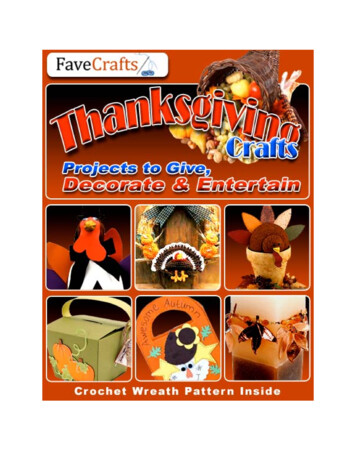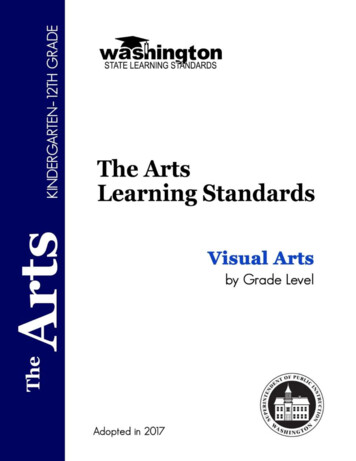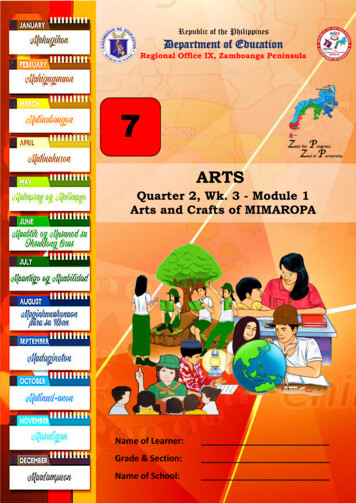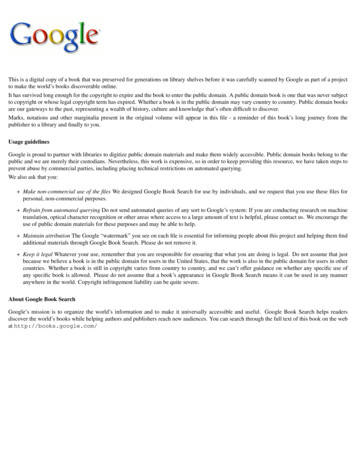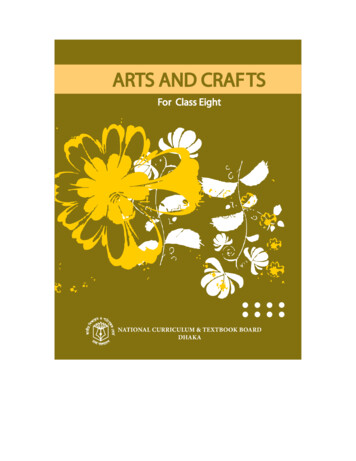
Transcription
ARTS AND CRAFTSFor Class Eight
Prescribed by National Curriculum and Textbook Boardas a textbook for Class VIII from the Academic Year 1998ARTS AND CRAFTS[For Class VIII]Written and Translated byHashem KhanGopesh MalakerEdited byShaheda ObaedNational Curriculum and Textbook Board, Dhaka
Published byNational Curriculum and Textbook Board69-70, Motijheel Commercial Area, Dhaka-1000[All rights reserved by the Publisher]First Edition : 1998Reprint : 2007Reprint March 2009Computer ComposeMars Solutions Ltd.Cover Design:Hashem KhanIllustrationHashem KhanGopesh MalakerAdeline MalakerDesignNCTB, DhakaFor free distribution from Academic Year 2010 by the Government of Bangladesh
PrefaceEducation is the key to development. A progressively improved education systemlargely determines the pace and the quality of national development. To reflect thehopes and aspirations of the people and the socio-economic and cultural reality in thecontext of the post independent Bangladesh, new textbooks were introduced in thebeginning of the 1980s following the recommendations of the National Curriculumand Textbook Committee.In 1994, in accordance with the need for change and development, the textbooks oflower secondary, secondary and higher secondary were revised and modified. Thetextbooks from classes VI to IX were written in 1995. In 2000, almost all thetextbooks were rationally evaluated and necessary revision were made. In 2008, theMinistry of Education formed a Task Force for Education. According to the adviceand guidance of the Task Force, the cover, spelling and information in the textbookswere updated and corrected.To make assessment more meaningful and in accordance with the need of thecurriculum, Creative Questions and Multiple Choice Questions are given at the end ofeach chapter. It is hoped that this will reduce the dependency of students on rotememorisation. The students will be able to apply the knowledge they have gained tojudge, analyse and evaluate real life situation.The social life in all areas revolves around art. To build a progressive nation andhealthy society, artists play a vital role together with doctors, engineers, agriculturists,educationists and politicians. Like the developed countries Arts and Crafts have beengiven an important position in education in developing countries. Practical lessonshave been given in the texts so that learners can learn to apply their knowledge inpractical fields. It is hoped that the textbook has rightly reflected the need of thecurriculum and the learning outcomes.This book of Arts and Crafts for class VIII is the English Version of the originaltextbook entitled ‘Charu O Karukala’ written in Bangla.We know that curriculum development is a continuous process on which textbooks arewritten. Any logical and formative suggestions for improvement will be consideredwith care. On the event of the golden jubilee of the Independence of Bangladesh in2021, we want to be a part of the ceaseless effort to build a prosperous Bangladesh.In spite of sincere efforts in translation, editing and printing some inadvertent errorsand omissions may be found in the book. However, our efforts to make it more refinedand impeccable will continue. Any constructive suggestion towards its furtherimprovement will be gratefully considered.I thank those who have assisted us with their intellect and efforts in the writing,editing and rational evaluation of this book. We hope that the book will be useful forthe students for whom it is written.(Prof. Md. Mostafa Kamaluddin)ChairmanNational Curriculum and Textbook BoardDhaka.
Preface and Directive for the TeachersThis Textbook on Arts and Crafts has been written according to the Curriculumand Syllabus. Arts and Crafts are paintings. Crafts is hand wrought. For thisreason the teacher has to make conscious effort to co-operate and make thestudents understand the rules and the lessons according to the descriptions givenin the book. The teacher should be careful about the collection of materials andhow these are to be used by the students. It has to be mentioned that the studentsshould draw paintings and make the crafts themselves. The teacher should neverinterfere with their works. He/she only will observe the dimensions andmaturity of the students' works and advise them. The teacher may point out theeasy rules and common perceptible objects of a painting by doing it in motherpage and demonstrate separately how to do a craft, if necessary. As arts is ahand-wrought subject, the role of an art-teacher is so important. This willencourage the students to be self-reliant and grow self confidence.Every year there should be an exhibition of the students' arts and crafts in allschools and the best work of art should be encouraged with awards and prizes.The students eagerness to improve these craftsmanship in paintings andhandicrafts if they get the opportunity to participate in the national andinternational handicrafts exhibitions & art-competiontions.One should attend art-exhibitions and visit different museums if he/she goes forair excursion to a big city.The students should be encouraged to visit the art-colleges and other artinstitutions to observe the various methods and the media of arts and crafts. Thestudents have to gather the knowledge that there are many other methods, toolsand media besides the text of the book.
Examination and Distribution of Marks:Full Marks - 501.Theoretical - 20 marksA. Descriptive - 10 marksTwo questions out of four to be answered 5 5 10B. Objective (multiple choice) - 10 marksTen questions to be tick marked 10 1 10There will be questions from every chapter2.Practical - 30 marksA. Fine arts (painting) - 15 marks(a) Class work - 5 marks25 paintings must be done through out the year as class work(b) Examination- 10 marks.One painting in examination.Time limit for one painting in examination- 4 hours or as needed.B.Handicraft /Cottage /Crafts - 15 marks(a) Class work- 5 marksTwo subjects must be learnt throughout the year.(b) ExaInination-10 marksStudents will learn about any two objects from the handicrafts/cottage/crafts portion, but will attempt only one in theexamination.Time limit - 5 hours or as necessary.
CONTENTSChapterOneSubject1. The necessity of Drawing PicturesPage12. Aesthetic Arts, Crafts and Folk Arts103. Ancient Arts and Culture of Bangladesh164. Media and Equipment for Drawings215. Panit and Coloured Picture336. Handicrafts and Cottage Industry/Crafts467. Crafts with Jute538. Crafts with Cotton and Cloth599. Wood-Crafts6510 Paper-Work and binding Books73Three11 Embroidery77Four12 Crafts with Rejected Waste Materials97Two
CHAPTER-ONEThe Necessity of Drawing PicturesThe drawings of pictures and other arts help men to enrich themselves and maketheir lives beautiful. So, if children are taught from childhood to be eager todraw pictures, they will be able to judge what is elegant and what is not, besidesthis studying other subjects students will be able to make their tasks beautiful.Let's see how a student can improve his talent by practising to draw and paintpictures and how lots of qualities may be widened in a person through practisingthe drawing pictures and other fine arts.What a child does, when he/she draws a picture ? What he thinks ? What is thesize of his drawing-paper? Suppose, the measurement of the paper is 37 25 c.m.The child wants to draw a picture of a village. A few houses, trees, the bank ofrivers, the boats tied by the river side, women working in the ghat (landingstair), cows grazing in the field, birds flying and many other things like thesemay be drawn. He tries to include and express beautifully so many things ofsuch a big village scene in a small piece of white paper. Through, this,decorating things beautifully and concentrated feelings discipline is practised inthe child's mind. Then he thinks about the colours, how and where to apply aparticular colour on the subject so that the picture looks nice. Then he usescolours to make the picture as beautiful as possible. Through choice of coloursand making beautiful pictures the child can realise which is elegant and what isnot, develops the recognition of beauty in him. Through drawing many picturesthey develop habits to do the artistic and beautiful things. He becomes selfconfident to produce beautiful piece of art as he grows up. He becomeshabituated to look keenly at nature, surroundings, men, animals etc. when hethinks about the subjects of paintings. In this way the child gains a lot ofknowledge about many things. This child, when he grows up becomes capableof taking any responsibility. Suppose, he becomes a director of an institution inwhich two hundred men work. It will be easy for him to develop the institution,dividing these two hundred people into systematic groups because he canvisualise the institute like a picture. By developing a habit of painting and
2Arts & Craftsdrawing pictures’ a person can be a good citizen, because in developedcountries drawings paintings is a compulsory subject like any other subjects.Let us think in a different way. If any one wants to take arts and paintings as aprofession, that is, if one who wants to be an artist after growing up, thenpractising arts from childhood may be very helpful.The artists are a very important and necessary part in all the spheres of activitiesof social life in Bangladesh.The artists taking up arts as profession in various spheres of activities they are:The professional craftsmen in the village, such as:blacksmith, potters, weavers, goldsmiths, spinner and craftsmen of bamboos andcanes. The girls and women do embroidered quilts, shital pati (mat) zainamaz,durries, fans etc, by weaving and doing embroidery works. The arts which arebeing practised by the general people from generation to generation, from era toera, have been named as 'Folk-arts', Arts' and 'Crafts'. The eagerness of themodern people has been growing rapidly in the field of folk-arts, arts and craftsfor day to day living. For this reason, all kinds of craftsmanship and fine arts isneeded to be practised, to be skilled and perfected.Artists are doing responsible jobs in various spheres of modern life. The artistsare needed for publishing books and news papers. Importance of drawing ismany fold in education, specially in engineering, medical science, sculpture,different-science education, history, geography etc. Artists are needed for everytelevision programme. It is not possible to do any drama or cinema without afine-artist and set decorator.In various industrial designing, that is:- to make the designs of the shapes andperfect forms of air-bus, aeroplane, ship, car, bus, train, television, radio,household metal utensils, key, lock, electric-light, fan, bottle, pots, jar etc. Evenpen, pencil, knife and different furniture, an artist or craftsman is very muchneeded. The fine artist and craftsman make designs for the boxes of books,various covers of things. The painters work for the advertisements, posters andsignboards too. The fame of the fine artists of Bangladesh has spread over
Arts & Crafts3the world for the designing of dresses,sarees, panzabis and paintings also.As a doctor, an engineer, a skilledadministrator, conscious politician anda lawyer is needed for the society, apainter is equally needed to make asociety nice, dignified and complete.Painting is the language of All MenThere are many countries and many nations all over the world. All of them havedifferent languages. A man learns two or three more languages according to hisneed. But a few linguists can learn eight to ten languages.The paintings were the medium of exchanging ideas and thoughts of men fromthe primitive age. The primitive men expressed their ideas, views and thoughtsby drawing pictures and various signs. The letters of different languages havecome from these pictures and signs. You will be able to know gradually aboutall these by reading books. A true story about how pictures can be the languageof all men is narrated here. A famous writer's house is in Dhaka city. A homelygathering has assembled there and made a complete gathering by the presenceof writers, artists, singer and other intelectuals. The discussions ranged frompolitics, economics, literatures, cultures and many other subjects.The event took place a long ago, perhaps in the year of 1963 or 1964. Dr.Mohammad Shahid-ullah, Dr. Md. Enamul Haque, Munir Chowdhury,Professor Mansur-uddin and more other like them were among them. Therewere long discussion of the various languages all over the world. At one stageone of them said that, he could read, write and speak in five languages, then thediscussion started discussed as to, how many languages everyone knows, Dr.Md. Shahid ullah knew many languages. He was specialized at least in eighteenlanguages.Some of them knew three, some four, some five and some two languages. Theatmosphere was vibrant with all these discussions. One of them was listeningattentively sitting quietly in a corner. After a long time he said, ‘Listen' I have
4Arts & Craftsbeen listening to all your conversations. Some of you know two, some three,some four or five languages. Dr. Shahidullah is the exception. He is an expert inmany languages. But I know a little bit of my mother tongue and English.Besides this I do not know any other language. But I know a language whichmay be called the language of the world or the language of all men. Because thepeople of every corner speaking any language will understand this languageeasily. None of you know this language.All of them in the meeting looked at this person sitting in a corner. Listening tohim, all became speechless. All tried to recover the meanings of his words.After some time they could realize the real significance of his words andbecame highly delighted with joy. They answered, "Yes, right you are of courseyou can, you have that quality".The person who was speaking like this was Shilpacharya Zainul Abedin. Hepainted pictures. And it is true that everyone can understand pictures. Tounderstand pictures of one country is not at all difficult for the people of anothercountry, though they may speak in a different language. We could easily learnabout the primitive men, their life style, societies etc. We could know about thegradual changes and evaluation of mankind of the world from the arts whichwere done in different ages of different countries. We could also learn about thesocieties and cultures of the very early periods."The painting is the language of the world or everyone's language", this namewas given by Shilpachariya Zainul Abedin. He gave a description of anexperience about this name in that gathering.He went on a travel to Europe at that time. Travelling a few countries of Europevia Paris, he reached Spain. He could manage by speaking a little English inother countries but in Paris he met with a strange incident. The French-peopleare so conscious about their language that they do not speak any other languageexcept their mother tongue, though they know English and other foreignlanguages. In Spain it is the same. The Spanish do not want to speak in anyother language except their own language. Even if they learn any other they aretactful enough not to disclose it. Only if they face any unavoidablecircumstances on feeling sorry for somebody, only then some of them come
Arts & Crafts5forword to speak in a foreign language, otherwise not, Of course, it is not soeasy to find a person, who knows any other language.While in Paris Zainul Abedin had learnt a few words of French for conveniencewhile travelling, such as Excuse Moi (excuse me), silvous plait (kindly), parglevous Franchais (Do you know French), pargle vous Englais (Do you knowEnglish?), merci beaucoup (many thanks), and monsicur etc. But these fewwords are not enough for travelling extensively.The artist faced a difficult situation when he arrived in Spain. He knew nothingabout Spanish. Though he knew a few French words, these are absolute here.Asking, pargle vous Englais, he roamed here and there but a person knowingEnglish could not be found. Entering a restaurant the artist would follow theactivities of the people from distance. He would not sit in a crowd, when thespace was vacant he would choose a lonely table. He tried to make the waiterunderstand by making signs, what he wanted to eat. He often became tired totrying to make them understand but he failed to make them understand, what hewould like to eat. So, there was no way but to depend on the waiter's mercy. Hecould not get the food of his taste.Something happened at noon one day. The artist was hungry. He sat at an emptytable in the varanda of a restaurant. He looked around for a hotel boy, butcouldn't find out. A gentle man was eating a fried-prawn with a bread at a littledistance. Seeing the decorated prawn in his dish, the artist wanted to eat it. Hehad almost forgotten about the last time he had tasted prawn ask in his homecountry. Seeing prawns that day, he had an ardent desire to eat it, after a longtime. For this reason he began to search for the waiter (hotel boy). But there isno trace of him. He could have given the order for food easily showing thegentle man's dish, if the waiter could be found. Finally, what he hadapprehended, actually happened. The gentle man went away in front of himafter eating , so he could not give the order by pointing at his plate of prawn.The waiter (hotel boy) came back after fifteen minutes. He was very busy.Inside there was a big crowd of people. The waiter asked him in his ownlanguage what the artist wanted to eat. To be answered in a hurry as he had no time.
6Arts & CraftsShilpachariya Zainul Abedin is trying to make the waiter (boy)understand what food he will takeThe artist Zainul Abedin tried to make the waiter understand his wish bypointing at the empty table, where the gentle man was eating the fried-prawn.He tried his best to make him understand about the fried-prawn. The waiterrattled in French morning a in number of food, but a single word was notunderstood. Zainul Abedin gave up the hope of eating the much desired friedprawn. But the waiter was obstinate. He was not willing to disappoint thecustomer. He told the artist to follow him inside by gesture. In the restaurant itwas very crowded. The waiter took him inside the kitchen, passing manypeople.The kitchen was very neat and clean. Most of the workers were girls. It seemedthat the waiter told them about the artist. All of them looked at the artist with
Arts & Crafts7smiling faces and pity. They began to display the legs of this and that to ask theartist what kind of food he wanted. The artist was answering politely nomonsicur no monsicur. It continued for a long time. He felt ashamed. But thegirls were not at all annoyed. The more he refused, with more hospitality theywere showing him -all the food which were being cooked, one by one from thekitchen of the restaurant. Suddenly, one of them showed a leg of a prawn, thenthe artist had a smile on his face. The girls were dying with laughter. For thisordinary thing lie had done so much! He fell so ashamed, he thought he shouldnot have done so. All, of the restaurant were smiling. The waiter was servingShilpachariya Zainul Abedin drew the pictured to make the waiter understand what food hewanted to eat and also drew that he would not drink the wine
8Arts & Craftsand smiling too. The girls of that kitchen will have something to laugh about fora long time thinking about this brown man's activities. He was eating the prawnunmindfully and was thinking. But it was nobody's fault, so what could I do ? Icannot speak their language, and can't make them understand!Suddenly he had an idea. He decided that, he would come to the same restaurantin the evening for dinner. That waiter appeared with a suppressed smile as soonas he entered the restaurant at night. Zainul Abedin did not feel depressed at all.He took out the pencil from his pocket and opened an exercise book. Thenbegan his tasks. He drew a pan to boil eggs and one fry-pan on the other side ona white paper. Then drawing a big cow, a back-thigh of the cow he put an arrowsign towords the boiling pan. That meant, he wanted to eat the cooked meat ofthat thigh. Then an egg of a hen, cauliflower, potato and all necessary foodswhich he wanted to eat was drawn one by one. The waiter was very muchamazed. There was a big crowd in short time. Many people gathered in thewhole restaurant. They were noticing the artist's new and amazing process ofgiving an order for food. The artist lifted his head and looked around after along time. Answering the question in their eyes he disclosed his identificationthat he was an artist. Everyone was delighted and wanted to help him. One ofthem said Excuse me' in English, then came near him eagerly and asked, "MayI sit ? .May I help you ?" The waiter rushed to the kitchen to bring food, whichwere drawn in the sketch-book. All foods were served in a short time.The gentle man, who knew English invited him to his residence. He wanted tointroduce the artist to his other friends. Shilpachariya Zainul Abedin never againfelt inconvenient to travel in foreign countries, after that. Because, he used tokeep the sketch -book and pencils with him.ExerciseTheoreticalA. Put 'tick ( ) marks to the correct answers.1. What is beautiful and what is not can be judged through drawing a picture.2. Sense of discipline and taste for beauty grows in people's mind by drawingpicture from childhood.
Arts & Crafts93. The studies have been ruined by drawing pictures from childhood.4. It is possible to know a lot about people, animals, nature, environment andmany other subjects by drawing picture from childhood.5. Drawing picture, makes a man not brave but timid.6. By drawing pictures studying about other subjects can be improved.7. There will be no disadvantages without artists in human society.8. The artists are very necessary in different media as television programmes,dramas, cinemas etc.9. Drawing pictures and other craftsmanship is a luxury for our poor society.10. Designs of garments, crafts of leathers and gunnies has become a famousin foreign countries.B.1.2.3.WrittenWrite in short about the necessity of drawing pictures in the human society.What qualities grow in a child by drawing pictures ? Explain.In which spheres of human society are the artists contributing ? Give adescription.4. How could Shilpachariya Zainul Abedin prove that 'Drawing picture' is thelanguage of all men ? Write briefly in your own language.5. Suppose you are in a restaurant in China, you want to eat something. Theydon't know your language. Draw a picture about what you want to eat tomake the hotel people understand like Shilpachariya.
Aesthetic Arts, Crafts and Folk ArtsAesthetic ArtsThe pictures, which children draw can be named ‘Childrens' Arts. Elders drawpictures with various medias. These are called Arts'. Statues or forms which aredone with wood, cement and stone are called 'Sculptures'. The planning ofdesigns of houses, different buildings, institutions, monuments etc. is calledarchitecture. Making all planning of designs and to give shapes of buildingsmarkets, cities, settlement of a township, a human colony, zoos, parks,stadiums, even all planning, are called architectural arts.Fine arts, sculptures and other arts are called 'Arts' in a word. The artist thinksabout a lot, when he does the art-works. He keeps in mind about his society,family and the people around him. The artist expresses tile mood of his emotion,happiness, sorrow and grief in his creations of 'Arts'. It will bring happiness topeople who will be able to identify their thoughts and life style with thepictures, their minds will be moved with its beauty, such thoughts inspire theartist's mind when there is some mysterious, appeal in the artist's creation, thenthose creations are called the ‘Aesthetic Arts’. ‘Aesthetic' came from the word“delightful”. Delightful means the ‘Paradise' (The garden of Eden).Men's need are two kinds. First one ismental-need which means the feelingsense of beauty. Another is physicalneed that means need of daily life.Fine Arts fulfill the menta1 need andCrafts help to fulfill the need of dailylife.CraftsPeople use arts in many ways to maketheir lives beautiful and to live inpeace and happiness. Even when thepoor villagers, farmers, workers buildhuts with bamboos, straw and hay(plant of fiber), they try to build themas neat and beautiful as possible.Aesthetic arts : A drawingby Qumrul Hassan
Arts & Crafts11They try to make different designs around the window-blind, they makedifferent designs with bamboos and canes and also make designs on doors andwindows. The reason for doing all these are inherent liking for artistic thing inevery man's mind. Every one wants to live nicely. The houses of the owner ofan agricultural farm, Zemindars or rich people of a village are kept neatly. Thereare various artistic designs of flowers, birds, creepers and herbs on the woodendoors, windows, the bedsteads, chairs, tables, different furnitures, railing ofvarandas and stairs are built will various craftsmanship and decorations. Thosefurnitures may be made of wood, irons even canes and bamboos. The owner ofa huge property, who has big palace, spends a lot to the arts in various aspects tolead his life nicely and luxuriously.People need thousands of things for their daily use and family lives. The peopleput various arts-forms in these articles. Such as clay-vessels, pitchers, flagons,plates, glasses, chillum-holders, betel-leafs pots made of brass and bell-metal.Heavy knives axes, spades, sickles, pans, mill stones/nut-crackers made of ironetc. These are made artistically and beautifully designed in sculptures and sometimes are decorated with creepers and herbs, flowers, birds etc. These utensilswhich are done artistically are called 'Crafts'. There are many other medias ofthe famous crafts of Bangladesh. Such as:A few crafts of bamboo, clay and iron
12Arts & CraftsThe furniture, chairs, tables, wicker, stools, various types (small & big) ofbaskets, trays, vessels, lids, wicker baskets for catching fish, small harpoons ofcatching fish, tortoise, crocodile etc. made of bamboos and canes, shikas, mats,bags, durries, zainamaj curtain, carpets etc. Ornaments of silver and gold arethe famous crafts of Bangladesh too. The vehicles-boats, palanquins (palki)rickshaws are famous as beautiful products of craftsmanship of Bangladesh inmany countries of the world. There are efficient work of arts in making boats ofdifferent shapes and forms and also carved designs are done on the boat'swooden parts.There are inscriptions on palanquins (palki) of the same kind. The boats areintroduced in various names for their appearances. Such as Gaina'; 'Panshi','Bazra', ‘Cosha', 'Sharang', 'Shampan', Dip', ‘Fishermen-boats' etc. Threewheeled richshaw is an art as its appearance and shape-like that, the rickshaw isdecorated with the designs of flowers, leaves, birds which are done by sewingand pasting plastics and clothes. Painted pictures are stacked behind therickshaw. Even the rickshaw is anattractive crafts. The handloom-sarees,various types of clothes weaven by theancient people of Bangladesh, bedsheets, shawls, blankets-baskets madeof bamboos and canes, top of thepillars. their ornaments, glass bangles,ear-shall-buttons, dolls, bone combs arementionable crafts of Bangladesh.Folk ArtsThere are similarity and connection between folk arts and crafts. When thepotter makes clay vesseles, pitchers then these are crafts and cottage-crafts.When, the pictures are drawn with colours on these clay vessels, then theybecome 'Shokher Haris', and are called Folk arts. On clay elephants of all sizeshorses and dolls of men are coloured with red, yellow, blue, pink. black andmany different colour very attractively. Putting these elephants and horses on awooden deck, when four wheels are fixed under these they may be used as toys.
Arts & Crafts13The embroidery quilt is a famous folk art of Bangladesh. The women and girlssew these quilts for day in various coloured designs with needle and thread intheir leisure time. Many stories and episodes are woven in these pictures. Themarried women express the story of sorrow and happiness of their own liveswith needle and thread in the pictures on their quilts. It takes one year,sometimes two years to sew a nice quilt. One can't help being astonished to seeit's artistic skill.Wooden ElephantClay dollTwo designed cakesThree designs of folk art of Bangladesh
14Arts & CraftsThe village girls do various weaving works with coloured thread jute-fibres,jute-ropes, Such as carpets (durries) Jainamaz, towels etc. These weavingthings and jute-shikas, shital-pati (a soothing and coolmat to lie upon) mats,fans made of thin-flat canes are our folk-arts and crafts.'Pot' is a kind of picture. There are a few artists who are God gifted avid candraw good pictures. They never learn to draw pictures in any art-schools orinstitutions. They paint pictures for their own pleasure or they may haveinherited this ability traditionally from their grandfather, father or uncle whomight have been doing this art of paintings and is carried on by the youngergeneration. 'Pots' are basically stories or episodes expressed in pictures whichare drawn on a long piece of cloth. They are cut into separate pictures, the storystarts from one piece and maintaining, the continuation story goes on. Theowner of the 'Pot' explains the story of the picture. The listeners enjoy the storyexpressed through the pictures. One example cf this kind of a famous picturestory of 'Pot' is 'Gazi's pot'. This art of 'Pot' is one of our mentionable folk-arts.The other folk arts of Bangladesh are dolls of sponge-woods, sea shelf-dolls.Lakshmi-shora, allpana (arts of painting on the floor, and embroidered threadedhand-fans
international handicrafts exhibitions & art-competiontions. One should attend art-exhibitions and visit different museums if he/she goes for air excursion to a big city. The students should be encouraged to visit the art-colleges and other art institutions to observe the various methods and the media of arts and crafts. The





